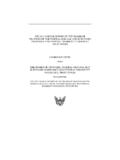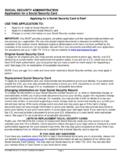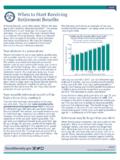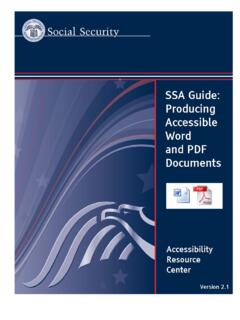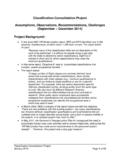Transcription of APPENDIX E Report of the Work Taxonomy and Classification ...
1 work Taxonomy and Classification subcommittee Content Model and Classification Recommendations APPENDIX E Report of the work Taxonomy and Classification subcommittee work Taxonomy and Classification subcommittee Content Model and Classification Recommendations This page is left intentionally Taxonomy and Classification subcommittee Content Model and Classification Recommendations Report of the work Taxonomy and Classification subcommittee of the Occupational Information Development Advisory Panel (OIDAP): Findings and Recommendations Regarding work Measurement September 1, 2009 Mark A. Wilson Shanan Gwaltney Gibson OIDAP Panel Member NC State University Department of Psychology OIDAP Panel Member East Carolina University Department of Management work Taxonomy and Classification subcommittee Content Model and Classification Recommendations This page left intentionally blank.
2 work Taxonomy and Classification subcommittee Content Model and Classification Recommendations E-iTable of Contents Executive Summary ..1 Preface ..2 Overview ..3 Purpose of the OIDAP and the OIDAP work Taxonomy and Classification Assumptions of the work Taxonomy and Classification Procedures ..8 Findings and Conclusions ..17 References ..19 List of Tables Table 1 Findings and Recommendations of the work Taxonomy and Classification subcommittee of the Table 2 Proposed work Taxonomy List of Figures Figure 1 Levels of Data Specificity within the Person Side and work Side Domains ..35 List of Appendices APPENDIX A subcommittee Members ..37 APPENDIX B subcommittee APPENDIX C Public Meeting APPENDIX D subcommittee Presentation ..57 APPENDIX E Table of APPENDIX F Empirical work APPENDIX G Empirical work Taxonomy Dimensions ..77 APPENDIX H Dimension Consolidation.
3 91 APPENDIX I Initial Taxonomy Person Side work Taxonomy and Classification subcommittee Content Model and Classification Recommendations E-ii This page left intentionally blank. work Taxonomy and Classification subcommittee Content Model and Classification Recommendations E-1 Executive Summary This Report describes the central and seminal role of Industrial and Organizational Psychology in determining the link between work and the demands work places on the worker (see page 2). Linking the world of work and the required human attributes to perform work is the key problem in work disability determination. By making clear the assumptions that place constraints on our efforts (see page 5), describing a method of due diligence involving both extensive field interviews and observations (see page 10), detailing the review and consolidation of previous empirical work taxonomies (see page 10), we have reached a clearly indicated set of findings and recommendations (see page 13).
4 The heart of these recommendations is that we believe the SSA must develop their own internal occupational analysis unit, staff it with experts in the field of occupational analysis, carry out pilot studies to refine work measurement instruments that consist of behavioral and observable descriptors, launch a nationwide occupational analysis system, and encourage extensive involvement from the scientific and user communities while doing so (see page 27). These findings and recommendations were made based on the current state of the scientific literature concerning work analysis (see page 19) and are designed to maximize the defensibility of the new occupational information system. We feel that, barring any delays due to external reviews, the vast majority of our recommendations can be carried out over an eighteen month period.
5 Because data that will be collected as part of the OIS Pilot Study is a prerequisite and foundational to all other recommendations, its completion must be an SSA priority. Finally, a glossary is provided to help the reader better grasp the technical nature of the issues discussed in this Report (see page 23). work Taxonomy and Classification subcommittee Content Model and Classification Recommendations E-2 Report of the work Taxonomy and Classification subcommittee of the Occupational Information Development Advisory Panel (OIDAP): Findings and Recommendations Regarding work Measurement Preface Job and work Analysis are often described as foundational because the information generated by these activities is used as the primary input into several decision making systems involving people at work . A completed work analysis is of no value until the results are used by one or more of these systems.
6 The implication of this insight is that any error committed as part of a work analysis will impact the many other systems which are, in part, based on the work analysis results. Describing work is not easy, requires considerable resources, and needs to be frequently updated (Wilson, 2007). work analysis done incorrectly can result in inaccurate decisions and unfairness for those affected by the decisions. work analysis that is not accurate and complete is likely to be challenged, will not be defensible, and will need to be redone resulting in increased costs and wasted effort. What if you were interested in analyzing all work in the economy so that you could build an occupational information system for the purpose of determining work related disability and you also wanted to keep the information up-to-date?
7 To complete a work analysis it is important to know why the analysis is being done (purpose), what degree of specificity of work descriptors is required (specificity), who will be providing the information (source), what means will be used to collect the information (modality), and how you will determine if the information is acceptable for the desired application (evaluation). For work analysis experts, the answer to several of these questions is straightforward for the problem at hand but others require more explanation. Other parts of this Report will deal with issues of specificity, source, modality, and evaluation but the issue of purpose will be discussed in more detail here. Doing work analysis for the purpose of disability determination requires establishing a linkage between work and the human attributes required to complete the work .
8 Industrial and Organizational Psychologists have long been interested in using work analysis results to make inferences regarding what the work requires of the individual who performs the work (Harvey, 1991). The process of determining work demands on an individual ( , job specification) requires that someone knowledgeable in both human attributes and work analysis review the work information (that is, what activities are performed on the job), and then in some fashion infer the human attributes that may be required to do the work successfully. This process is an example of what scientific methodologists mean work Taxonomy and Classification subcommittee Content Model and Classification Recommendations E-3when they speak of making inferential leaps. Inferential leaps are often looked upon with some suspicion by scientists because the act of inference may involve human judgment and all the potential sources of error that result from such judgment.
9 For the process to be acceptable to other scientists, the expert must make the case that other experts looking at the same situation would come to the same conclusions. One way to ensure similar conclusions by other experts is to decrease the distance of the leap by identifying a series of judgment rules, or by conducting empirical research to confirm the predictions inherent in a job specification. The systematic linkage of the world of work to a comprehensive Taxonomy of physical, cognitive, and interpersonal attributes of workers has been a primary goal of Industrial and Organizational Psychology for some time (Dunnette, 1976). One major difficulty in establishing this linkage is that work is often described in different ways that make job-to-job comparisons difficult ( , by using different descriptors and metrics).
10 To the extent that descriptors used to describe work are concrete, observable, and behavioral they will be more likely to be evaluated with more consistency. Conversely, there is clear evidence that as job analysis descriptors become more abstract the evaluation of them becomes more difficult (Dierdorff & Wilson, 2003). Another benefit of a common set of descriptors and metrics is that it makes the process of comparing one job to another (a common task in the disability determination process) easier, more comprehensive, and provides less room for errors in human judgment. Describing work with a common set of descriptors and metrics is essential to establishing a linkage between the world of work and the attributes required of the worker because it will help minimize the distance of the inferential leap required. Overview This document describes the purpose, assumptions, procedures, findings, and recommendations, of the work Taxonomy and Classification subcommittee of the Occupational Information Development Advisory Panel (OIDAP).
